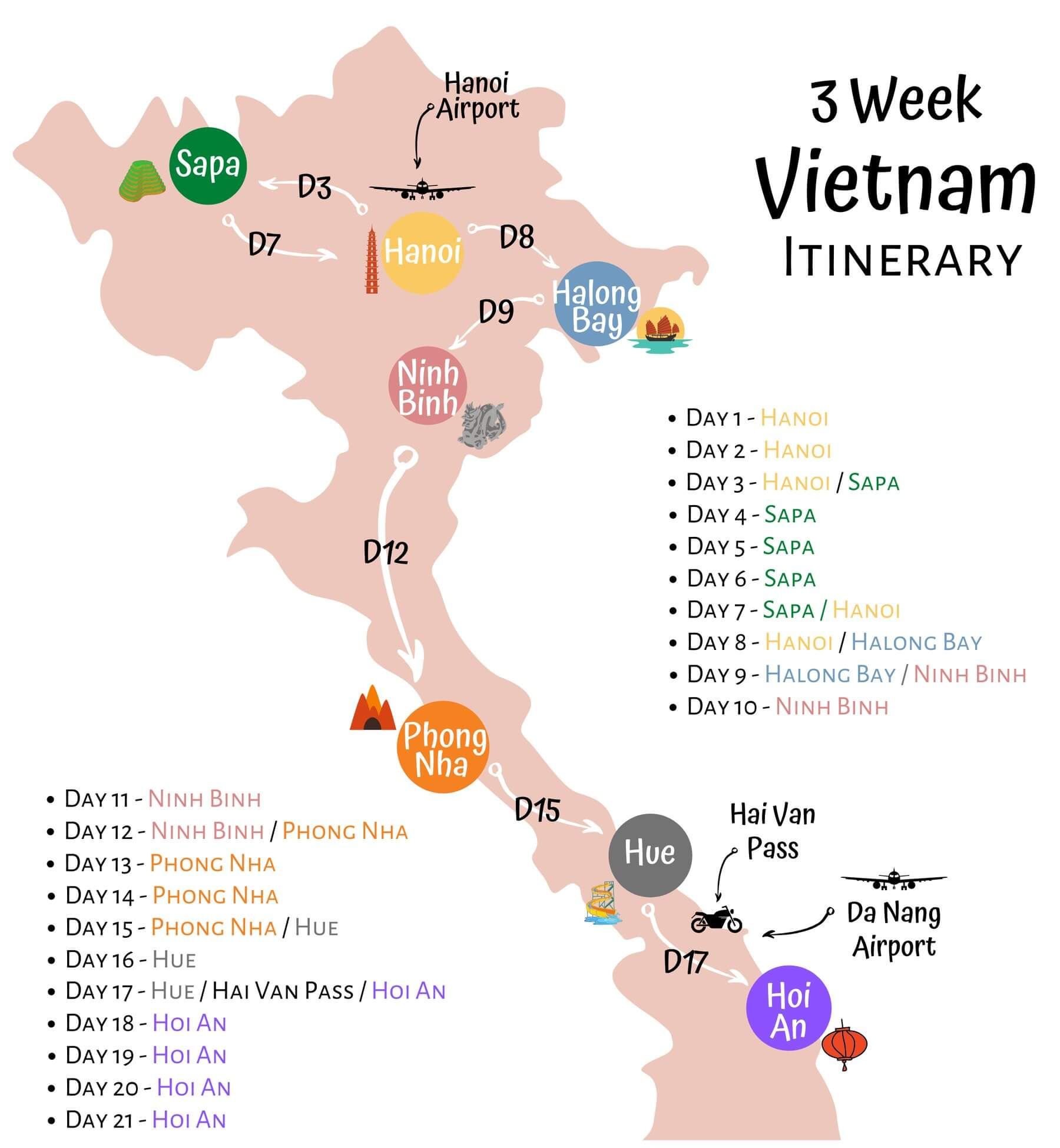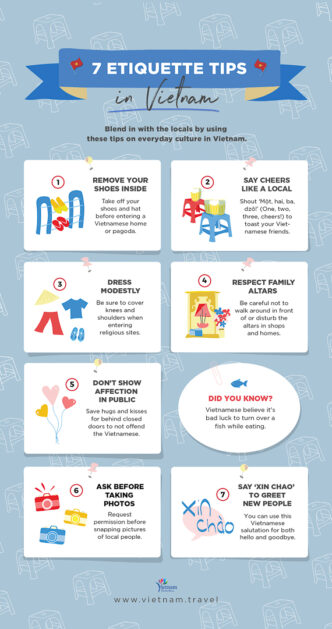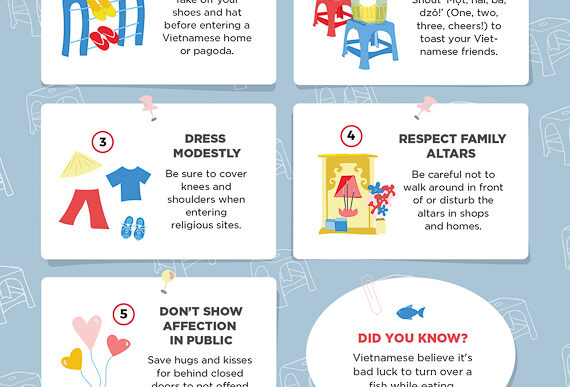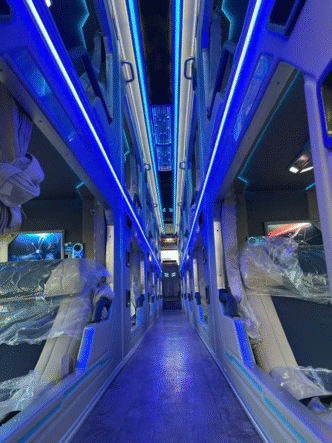Ultimate Vietnam Travel Itinerary: A Complete 3-Week Adventure
Vietnam is a country of stunning diversity, offering a rich tapestry of landscapes, history, and culture. Whether you’re an adventurous traveler, a history buff, or someone simply looking to relax on pristine beaches, Vietnam has something for everyone. Planning a trip to Vietnam can be overwhelming due to the wide range of destinations, but with the right Vietnam travel itinerary, you can make the most out of your visit.
This 3-week Vietnam travel itinerary will guide you through the best cities, attractions, and experiences the country has to offer. From the bustling streets of Hanoi to the tranquil beauty of Ha Long Bay, and from the ancient streets of Hoi An to the vibrant energy of Ho Chi Minh City, we’ll help you create unforgettable memories.

Week 1: Northern Vietnam – Hanoi, Sapa, and Ha Long Bay
Day 1-3: Hanoi – The Heart of Vietnam
Begin your Vietnam journey in Hanoi, the capital city. Hanoi offers a beautiful mix of ancient history and modern-day charm. Spend your first days exploring the city’s Old Quarter, with its narrow streets filled with colorful markets, shops, and street food stalls. Don’t miss the Hoan Kiem Lake, the Temple of Literature, and the Ho Chi Minh Mausoleum.
Hanoi is also home to some of Vietnam’s most famous culinary delights, such as pho, bun cha, and egg coffee. Try these local dishes at one of the many street vendors for an authentic experience.
-
Key highlights in Hanoi:
-
Hoan Kiem Lake: A peaceful escape in the heart of the city.
-
Ho Chi Minh Mausoleum: Pay respects to the founding father of Vietnam.
-
Street food tours: Try famous dishes like pho and bun cha.
-
Learn more about Hanoi’s hidden gems here.
Day 4-6: Sapa – The Mountains and Ethnic Villages
Next, head to Sapa, a stunning mountain town in northern Vietnam, known for its terraced rice fields, ethnic minority villages, and breathtaking landscapes. You can take a bus or train from Hanoi to Sapa, which takes about 8-9 hours.
Once in Sapa, explore the town and surrounding villages like Cat Cat Village and Ta Van Village, where you can experience the unique culture of the H’mong, Tay, and Dao people. Take a trek through the rice terraces, enjoy the fresh mountain air, and interact with the friendly locals.
-
Key highlights in Sapa:
-
Trekking through rice fields: Enjoy scenic views and immerse in nature.
-
Cat Cat and Ta Van Villages: Experience local culture and handicrafts.
-
Fansipan Mountain: Hike or take the cable car to the “Roof of Indochina.”
-
Day 7: Ha Long Bay – Natural Beauty
End your week with a visit to Ha Long Bay, one of Vietnam’s most iconic destinations. Known for its emerald waters and limestone islands, Ha Long Bay is a UNESCO World Heritage site that will take your breath away. You can take an overnight cruise or a day trip from Hanoi to explore the bay’s stunning karst formations and caves.
While here, you can also visit Cat Ba Island, enjoy water activities like kayaking, or take a boat ride to discover hidden caves and floating villages.
-
Key highlights in Ha Long Bay:
-
Cruise through the bay: Enjoy the beauty of limestone islands and caves.
-
Cat Ba Island: Explore beaches and hiking trails.
-
Water activities: Kayak, swim, and snorkel in crystal-clear waters.
-

Week 2: Central Vietnam – Hue, Hoi An, and Da Nang
Day 8-10: Hue – A Journey Through History
Travel south to Hue, the ancient capital of Vietnam. Hue is home to the Imperial City, a vast complex of palaces, temples, and gates that were once the seat of the Nguyen emperors. Take a guided tour of the Citadel, visit the Royal Tombs, and explore the Thien Mu Pagoda.
Hue is also known for its delicious food, including Bun Bo Hue, a spicy beef noodle soup that you must try. Don’t forget to take a boat ride along the Perfume River to see the surrounding landscapes.
-
Key highlights in Hue:
-
Imperial City: Explore the ancient palace and royal tombs.
-
Bun Bo Hue: Savor the local spicy noodle soup.
-
Perfume River: Take a relaxing boat ride along the river.
-
Day 11-13: Hoi An – A Timeless Town
From Hue, head to Hoi An, a charming town famous for its well-preserved ancient architecture, colorful lanterns, and cultural heritage. Spend your time wandering the Old Town, which is a UNESCO World Heritage site, and visiting attractions like the Japanese Bridge and Hoi An Market.
Hoi An is also a great place to relax at the beach, shop for handmade lanterns, and experience traditional cooking classes. Don’t miss the Hoi An Lantern Festival, which takes place on the 14th day of each lunar month and transforms the town into a glowing wonderland.
-
Key highlights in Hoi An:
-
Old Town: Wander through ancient streets and shops.
-
Hoi An Lantern Festival: Enjoy the beauty of floating lanterns.
-
Culinary experiences: Try traditional dishes like Cao Lau.
-
Day 14: Da Nang – City of Beaches and Adventure
Just a short drive from Hoi An, Da Nang offers a blend of modernity and natural beauty. Relax at My Khe Beach, one of Vietnam’s most beautiful beaches, or take a trip to Marble Mountain for stunning views and exploration.
For an unforgettable experience, visit the Ba Na Hills, where you can walk across the famous Golden Bridge, held up by giant hands, and enjoy panoramic views of the city and surrounding mountains.
-
Key highlights in Da Nang:
-
My Khe Beach: Relax on one of the best beaches in Vietnam.
-
Golden Bridge: Walk across the iconic bridge in Ba Na Hills.
-
Marble Mountains: Explore caves, pagodas, and panoramic views.
-

Week 3: Southern Vietnam – Ho Chi Minh City and the Mekong Delta
Day 15-17: Ho Chi Minh City – The Heart of the South
Start your final week in Ho Chi Minh City (formerly Saigon), the bustling economic hub of Vietnam. Spend your days visiting Notre-Dame Cathedral, the War Remnants Museum, and the Ben Thanh Market. Take a walk down Dong Khoi Street to experience the city’s vibrant energy, blending old French colonial buildings with modern skyscrapers.
For a deeper insight into Vietnam’s history, take a day trip to the Cu Chi Tunnels, a network of underground tunnels used by the Viet Cong during the war.
-
Key highlights in Ho Chi Minh City:
-
War Remnants Museum: Learn about Vietnam’s history and the war.
-
Ben Thanh Market: Shop for local handicrafts and souvenirs.
-
Cu Chi Tunnels: Explore the underground network used during the war.
-
Day 18-20: Mekong Delta – Exploring the River Life
End your Vietnam journey with a visit to the Mekong Delta, a vast network of rivers, swamps, and islands in southern Vietnam. This region is known for its floating markets, traditional wooden boats, and lush landscapes.
Take a boat tour to explore the floating markets of Cai Be and Vinh Long, where you can see locals selling fresh produce and goods directly from their boats. You’ll also get the chance to visit small villages and experience the slower pace of life in the delta.
-
Key highlights in the Mekong Delta:
-
Cai Be Floating Market: Shop for fruits and goods on the water.
-
Boat tours: Explore the delta by traditional wooden boats.
-
Local villages: Experience the rural way of life in the Mekong.
-
Conclusion: Your Perfect Vietnam Travel Itinerary Awaits
Vietnam is a country that offers a little bit of everything—history, adventure, beaches, and delicious food. Whether you’re interested in cultural exploration or simply relaxing by the beach, this 3-week Vietnam travel itinerary ensures that you’ll experience the best of what the country has to offer.
By following this itinerary, you will discover the diverse beauty of Vietnam, from its historic cities to its breathtaking landscapes. Get ready to embark on an unforgettable journey through this remarkable country!
FAQs About Vietnam Travel
1. How much time do I need to explore Vietnam?
A 3-week itinerary is perfect for seeing the main highlights of Vietnam, allowing you to explore both the northern, central, and southern regions in-depth.
2. What is the best time to visit Vietnam?
The best time to visit Vietnam is from September to April, when the weather is cooler and more comfortable for sightseeing.
3. Is Vietnam an affordable destination?
Yes, Vietnam is a budget-friendly destination. Accommodations, food, and transportation are generally very affordable, making it ideal for travelers looking for great value.
4. What should I pack for a trip to Vietnam?
Pack light, comfortable clothing for the warm weather, a light jacket for cooler nights, and good walking shoes. Don’t forget to bring sunscreen, insect repellent, and a hat for sun protection.
Embark on your Vietnam adventure with this detailed itinerary and make lasting memories exploring this vibrant country!




